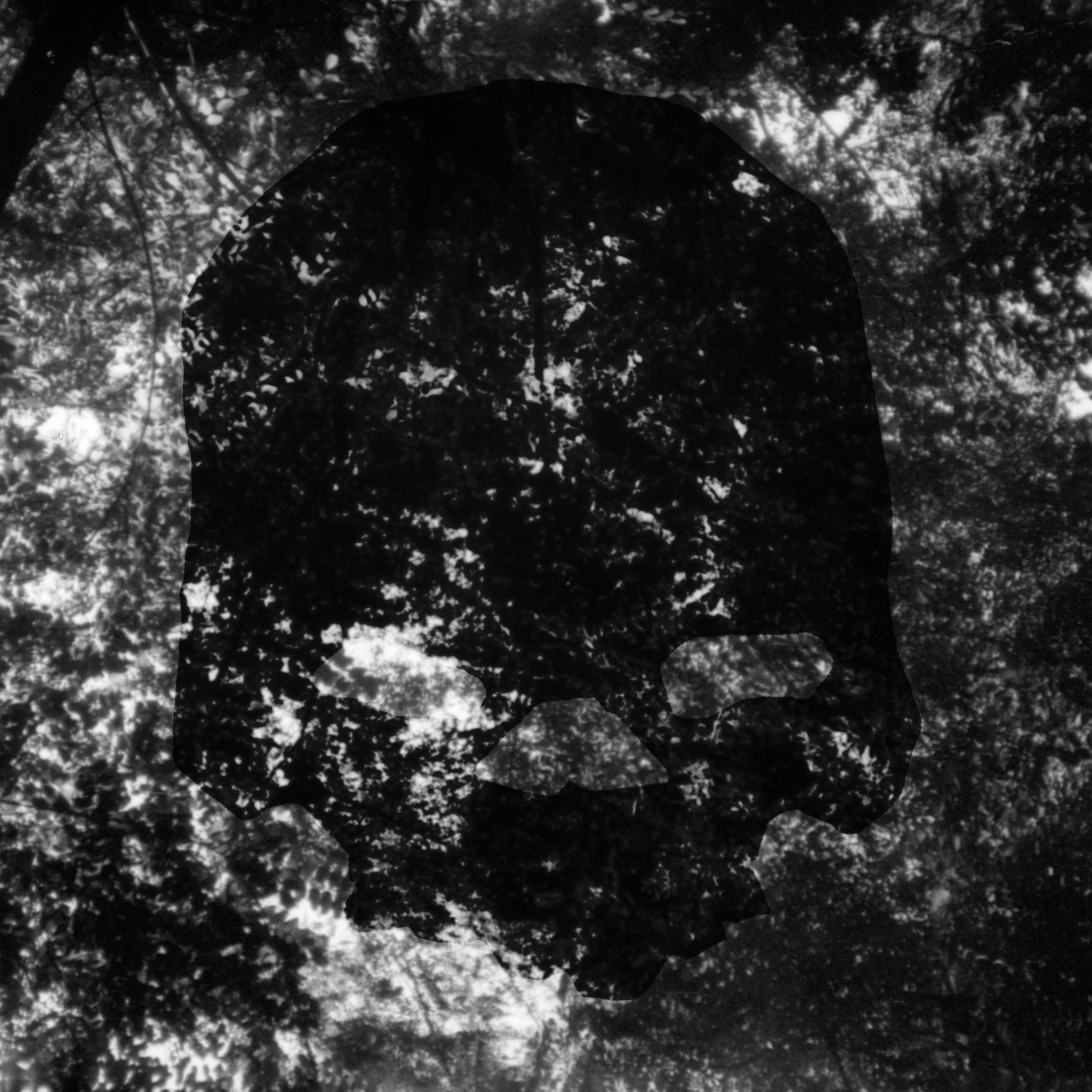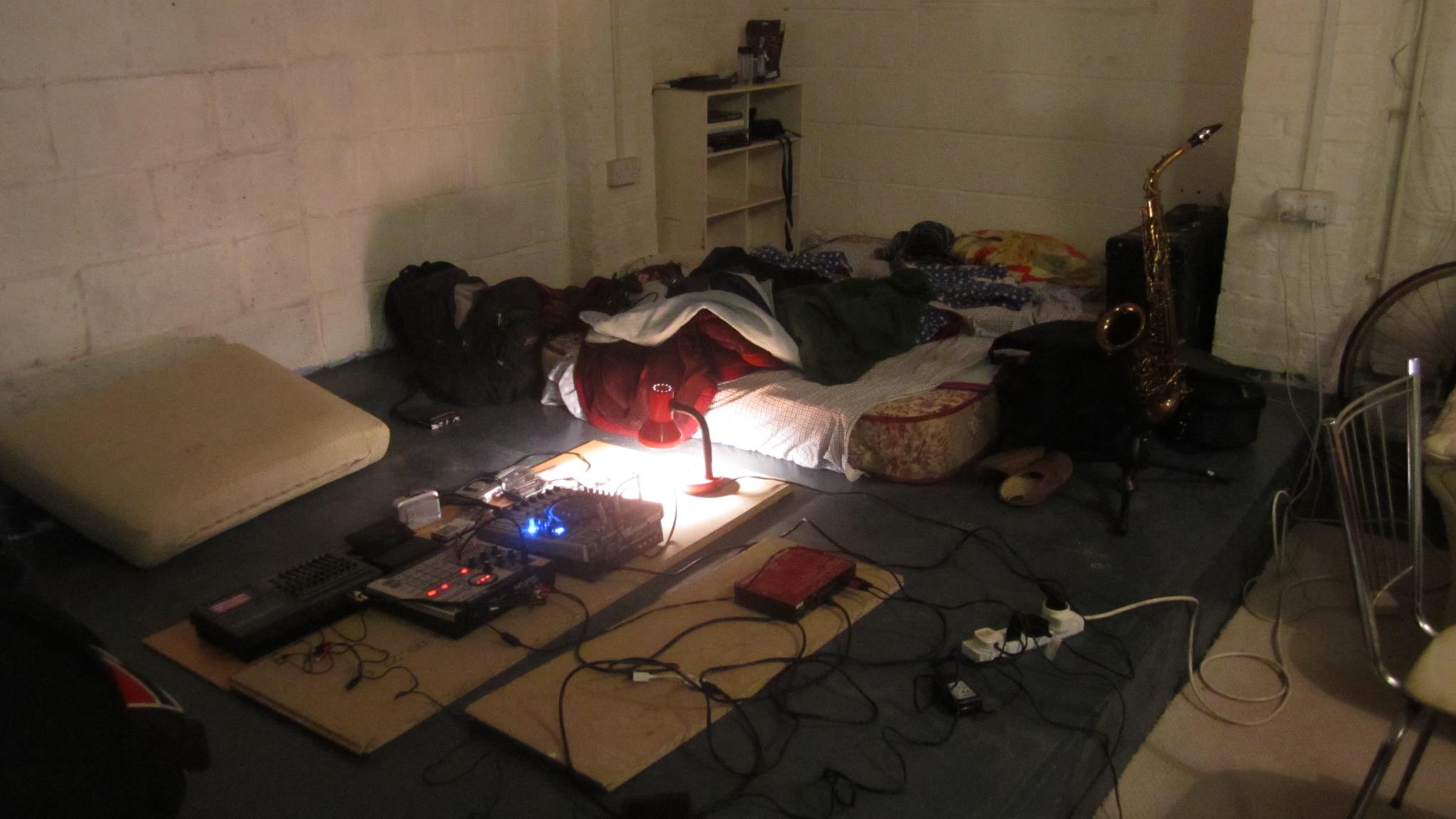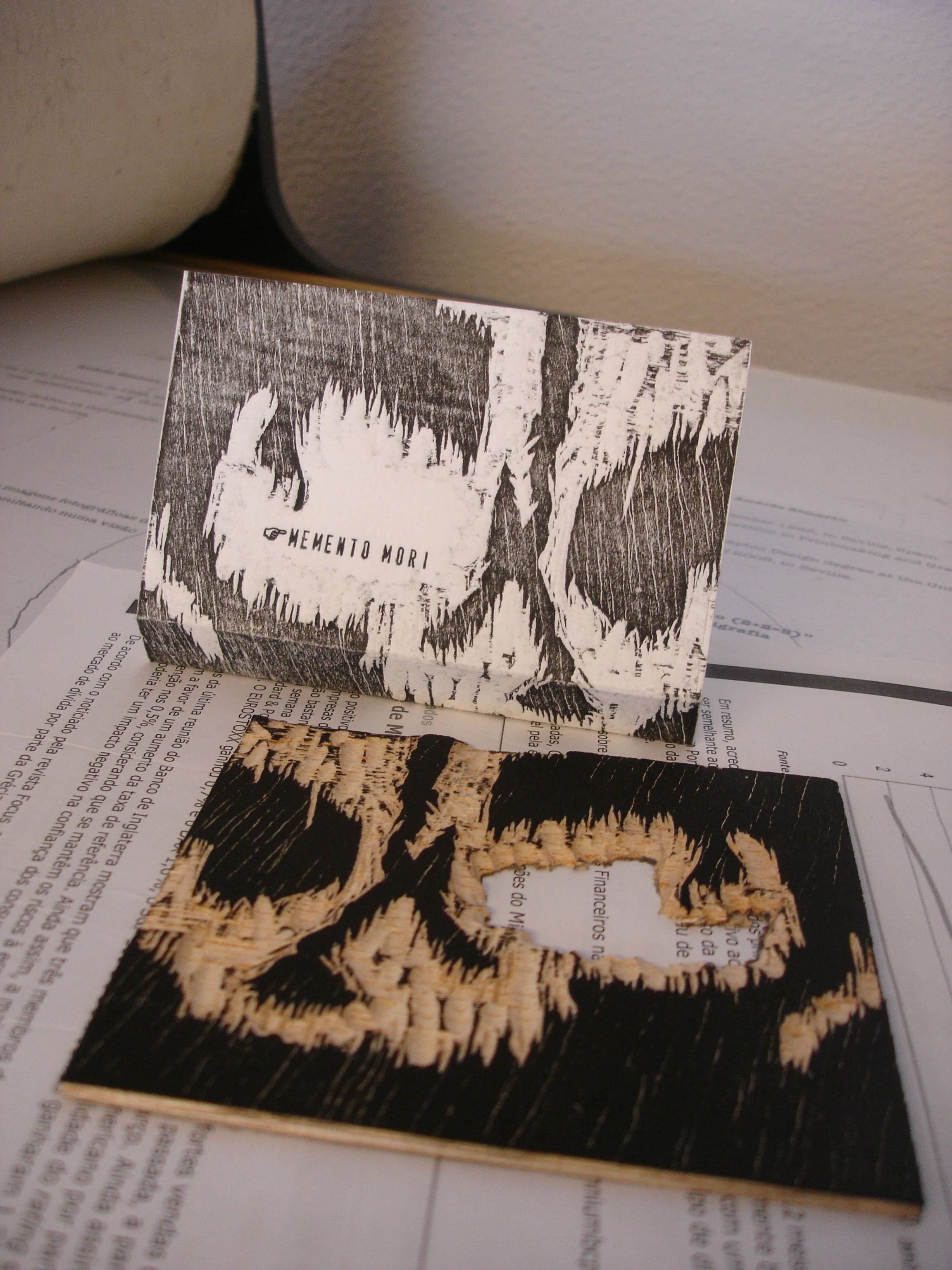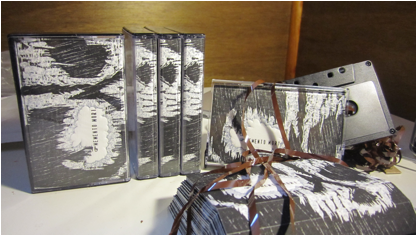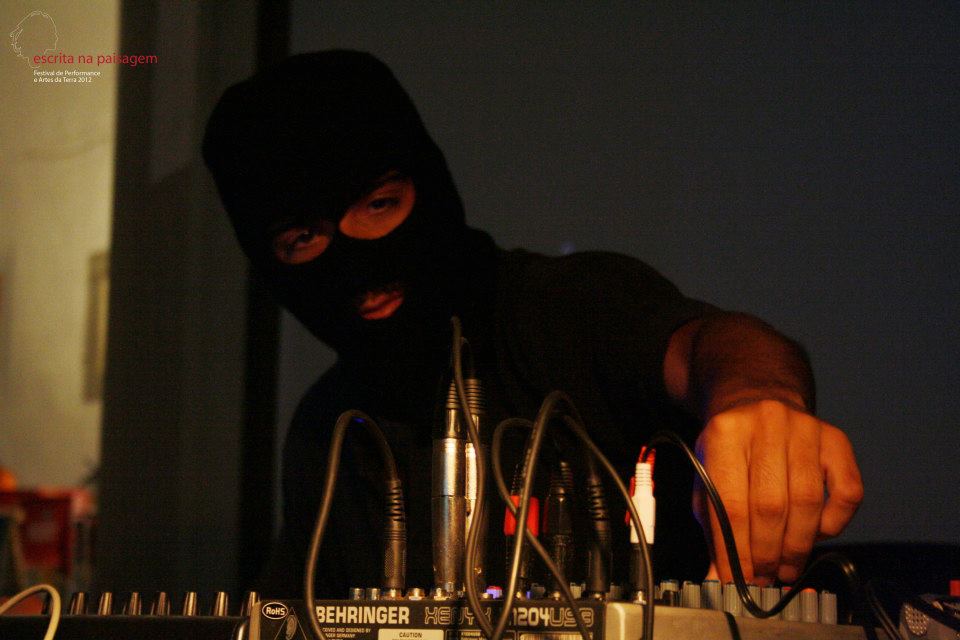RESEARCH AND CRITICAL APPRAISAL OF MEMENTO MORI
ANDRÉ PINTO — 2012
Memento mori is the converging of my areas of research into one concise project.
For a few years now I have been focusing a big interest in free improvisation and noise music. This interest has developed through a continuous research and reflection on art as the human practice of free beauty, its ontology and ‘purpose’, which went side by side with my libertarian ideas in what concerns to human life in society and the search for ‘total freedom’, whatever that means.
I have been actively involved in free improvised music practice for around four years, and ever since I have been engaged in a constant search for an instrument set-up that would fit me, thus constantly changing my sound tools. Yet, some tools have remained the same, and have been the most explored (practical and theoretically) and estimated into some kind of aesthetical identity, which I however try to avoid, in a way of not falling into formulas or repetitive patterns of creation. These tools are cassette recorders, radios and closed circuit feedbacks.
Thus, this project grew out of my interest in exploring the audiocassette medium. I assume cassettes have become quite a popular ‘fetish’ nowadays, which I share, given my personal history and relationship to it. But also this medium interests me for its ‘hands-on’ character, being a physical portable analogue medium, one has the power of experimenting with it in a very plastic way, and in my personal opinion, it sounds beautiful. Until here, my experiments with it were mostly in improvisation environments, where I would partially manipulate the recorded sound by interfering with the recorder or the actual cassette. I had also experimented with cassette tape loops before.
My idea was to make a piece that would somehow be specific for the cassette medium.
This project came out of the development of another vague idea I had of making an ‘anti-market’ DIY record to be distributed for free clandestinely, by planting copies in record shops, similarly to Banksy’s planted artworks in museums or his ‘re-edition’ of Paris Hilton’s album with remixes by Danger Mouse.
For the practical approach to the album I was inspired by Aki Onda, after a concert in Cafe Oto. Aki manages to improvise solely with his own cassette recordings and a basic set-up of effect pedals, and curiously, also plays a radio occasionally. His work influenced me in the ‘strategy’, let us say. Aki has been collecting his own cassette recordings throughout his life and makes them the core of his performance, so, at his image, I decided to start documenting field recordings, my solo and group improvisations and found cassettes as raw material for the whole project which would be composed out of them.
I was also highly influenced technically, in means of composition, by Rafael Toral’s ‘Space Elements Vol. III’ album. The album is completely composed out of solo performance improvisation recordings, which are later on edited and mixed together. This seemed to me to be a good way of being able to build a piece from my own material.
Conceptually, my interest has been the exploration of the boundaries of aesthetics, its relations with the social environment, the sociopolitical power of aesthetics, the vanguards as ‘noise/interference’ in relation to the established ‘aesthetical-codes’ . In this sense, this project is somehow an attempt of rendering the theories I developed in my dissertation to more practical terms.
Also, I have been very interested in exposing the different approaches to music creation, as a more spiritualist attempt of reaching closer to some conception of divine power, or as an attempt of expressing the human condition acting in a more ‘ground level’ human-sized expression. One can relate this with the ancient Greek dichotomy of the Apollonian and Dionysian myths of the creation of music.
From the beginning I had in mind Allen Weiss’ book ‘Breathless’ (2002) to be my main conceptual basis.
In his book, Allen Weiss discusses the im/materiality of sound recording as a disembodiment of its creator, a rendering of a ghostly subject that shall ultimately be the epitaph of its creative force. In analogy to Ong’s (2005) association of writing with death, Weiss takes a similar approach to show the relation of human and death, and how the relatively new technology of sound recording might have transformed our own symbolic approaches and relationships with nostalgia and melancholia, and mourning death.
‘One of the most startling paradoxes inherent in writing is its close association with death. This association is suggested in Plato’s charge that writing is inhuman, thing-like, and that it destroys memory.... In Pippa Passes, Robert Browning calls attention to the still widespread practice of pressing living flowers to death between the pages of printed books, “faded yellow blossoms / twixt page and page.” The dead flower, once alive, is the psychic equivalent of the verbal text. The paradox lies in the fact that the deadness of the text, its removal from the living human lifeworld, its rigid fixity, assures its endurance and its potential for being resurrected into limitless living contexts by a potentially infinite number of living readers.’
(Ong, 2005, p.81)
I believe this relation of death and the recorded sound was the perfect raw matter to work the dichotomy concepts I was exploring in music: ethereal/earthly, air/ground, spirit/matter, noise/silence, destruction/nihilism, anti-culture/counter-culture, vanguard/mannerism, life/art...
I started the project with a heavy theoretical ground worked out. From Weiss’ book I moved on to Edgar Allan Poe’s poems, which comprise a heavy content related to death, loss, melancholia and mourning, expressed in many different contexts and fabulous metaphors. The one that got my main attention as conceptual essence for my work was ‘The Oval Portrait’ (Poe, 1850). This poem is a very strong metaphor to what I was attempting with my project. The poem is about a painter eager to paint his wife, who does not really fancy the arts but is lead to pose for her husband because her love for him is strong. The painter spends long time at the task, working vigorously and passionately, each time more focused on the painting and less on his wife, striving for perfection. He does not notice that his wife is becoming more pale and her strength is decreasing, and by the time he finishes the painting he screams: “'This is indeed Life itself!' turned suddenly to regard his beloved: She was dead!” (Poe, 1850)
In this poem, the artist steals the life out of his beloved in the act of creation, he imprisons the ‘soul’ of his wife in the newly brought to life painting which disembodied from her to be kept as a ‘memento mori’, an affirmation of life by counterpoint with the unavoidable reality of death.
This was the reason I chose this title to the piece. Memento Mori is a Latin expression that means ‘remember you will death’ or ‘remember your mortality’ and it was a common theme among painters in medieval and renaissance times, where the painted motifs would usually be human skulls and sand clocks. I decided to make my own sonorous Memento Mori that would be self-redundant for it is aimed to be a memento mori of its own ‘bones’, of the pieces of sounds that it is composed of and ultimately a memento mori of itself as a re-recordable limited edition piece and of its medium that is walking towards obsolete.
Before starting the very practical work of composing I had a very heavy and wider theoretical baggage that I wanted to apply conceptually in the aesthetical outcome. I was dividing the 2x15 minutes in small portions that would work as different tracks so I could create a progression of aesthetics that would fit complex the logic I had created:
Side A – bove Air (mainly high pitched and reverberated):
1 Oval Portrait (voice text cutups + radio)
2 Requiem (sacred polyphonic music + feedback ‘choir’)
3 Monos (feedbacks + screams + tapeloops)
Side B – elow Ground (mainly low pitched, dry and rough-cut):
1 Una (loops + screams)
2 Danse Macabre (drums + loops + sax in)
3 Dead and Zarathustra (sax + voice text cutups)
The titles where inspired on my big interests at the time: Edgar Allan Poe’s poems (The Oval Portrait and Monos & Una), polyphonic church music and Nietzsche’s ‘Thus Spoke Zarathustra’ (2003). And the techniques were the attempt of making the project be specific for cassette but also inserting my improvisation set-up, for everything would be recorded on tapes and composition would come out of its manipulation.
The idea of making the project site-specific was not working very well except for my eager for it to be made specifically for cassette, which was enough for me. This goal made me drift into some side projects that came out of my studying of the medium to make a specific piece for it. Those other projects are scores that involve cassettes and recorders and cassette tapes as mediums of composition, and its features are the main focus of the composition. ‘Out of Air, Into Air’ which is a ‘re-assemblage’ I made out of my friend Tom Soloveitzik’s score for me ‘Air 2011’, uses as a compositional feature, the possibility of redubbing over skits of sound of any size in any place along the whole tape as a direct action that erases previous recording. ‘Score for a Broken Life Muzak’ takes advantage of the bit of silence left when one records in a cassette tape loop, by having a series of recorders connected that multiply this bit of silence by recording sound from the previous recorder.
Back to Memento Mori, my first idea and attempt to compose was to make a new ‘composition set-up’ that would not need the computer. This would involve a few cassette players, some effect processors, a mixing desk and a multi-track cassette recorder. I arranged everything but quickly realized that it would be impossible to keep on with that process. I had spent long time in field and performance recording and selecting, and now this set-up was a huge obstacle for me. To build something good I would have to practice techniques and skills that I did not have for it, and have a perfect knowledge of the contents of the cassettes and their times in them. Thus this process was dropped and I had to turn to composing digitally rather than analogically.
Other technical obstacles came in the way in the starting of the composition process. I intended to use Burroughs’ and Gysin’s recording and cut-up techniques and some ‘exercises’ from Burrough’s ‘Electronic Revolution’ (Burroughs, 2005), but it turned out to be impossible with cassette tape for its size makes it very hard to handle in pieces.
When actually composing the piece, much of the previous theoretical work was forgotten or put aside to give way to a free expression. This happened naturally, so I realized that I had to drop much of my conceptual baggage in order to be able to give some openness to my aesthetical process. This made the whole progression of conceptual track names disappear, and the whole piece was divided in 2 sections: Side A (Above Air) and B (Below Ground), whose titles are open enough to paradoxically comprise the dichotomies of spirit and matter, divine and human, and henceforth, which I believe they do.
Just now I believe I can theorize on the whole project and understand new things about it and modulate my theory to the practical outcome. I believe the piece has some ambivalence in what would be the ‘Above Air’ as a more ethereal composition and the ‘Below Ground’ as a more earthly one. I believe they complement each other progressively as a sonorous death trip. In my opinion is created a cycle in between the two sections: on the first part, the A side, there is the crescendo from the earth into an aerial state of trance and then down to the limbo between human and divine, with the sound of the Muslim call to the sacred rituals. The second part, the B side, begins with a crescendo that gets broken suddenly to give way to an immersive and chaotic mass of noise, an underworld that gets also broken into a cold silent tension of squeaking saxophones that resemble moribund creatures, and then a crescendo of frenzy builds up again as a runaway from death and is again suddenly killed with silence.
I believe that there is a very interesting character in the whole piece which is the ambiguity of the tracks in what concerns to the direct relation one makes with the concepts I tried to explore: that Above Air would be the ‘ethereal/spiritual’ side, and the Below Ground the ‘atheist/earthly’ one. I believe they are jumbled together to the point one cannot distinguish heart from bones.
BIBLIOGRAPHY
Burroughs, W., 2005. The Electronic Revolution. ubuclassics. Originally published in 1970 by Expanded Media Editions.
Nietzsche, F., 2003. Thus Spoke Zarathustra. London: Penguin Books. 1885.
Ong, W.J., 2005. Orality and Literacy: The Technologizing of the Word. New York: Taylor & Francis e-Library.
Pinto, A.G., 2012. The Territory from Chaos to Noise: an Introduction to Noise Music. London.
Poe, E.A., 1850. [Online] Available at: xroads.virginia.edu/~hyper/ POE/oval.html [Accessed 2012].
Weiss, A., 2002. Breathless. Middletown: Wesleyan University Press.
